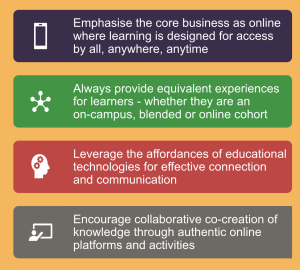Digital-first design
One key enabler of HyFlex learning is applying digital-first design strategies that explore the relationship between synchronous and asynchronous modes. Appropriate digital-first design strategies can re-conceptualise student engagement and online learning within a HyFlex classroom.
Digital-first learning design means designing learning for the core business of online learning. It means designing for asynchronous online learning modes from the beginning or “first,” using techniques that provide the HyFlex attributes of choice, flat learning, and accessibility. Synchronous opportunities can then be placed on top of the essential design rather than being integral to student engagement and success.
Therefore, in support of social, cognitive and teaching objectives, digital-first learning design means you:
- Start with the online space as the essential means of exchange and collaboration
- Lay out the communication and multimedia in a way that flows for students
- Design learning experiences that suit the modality and use the affordances of technology
- Create/convert all learning resources for online at all times from the start, e.g., there should be no handouts that only on-campus students receive
- Design learning activities to be interactive and collaborative that are scaffolded by online spaces and resources
Digital-first learning design means designing for asynchronous online learning modes from the beginning or “first” using techniques that provide for HyFlex attributes of choice, flat learning and accessibility.


Media Attributions
- Digital first design © Julie Lindsay is licensed under a CC BY-NC (Attribution NonCommercial) license
- Enabling HyFlex Learning with Digital First Design © Julie Lindsay is licensed under a CC BY-NC (Attribution NonCommercial) license

